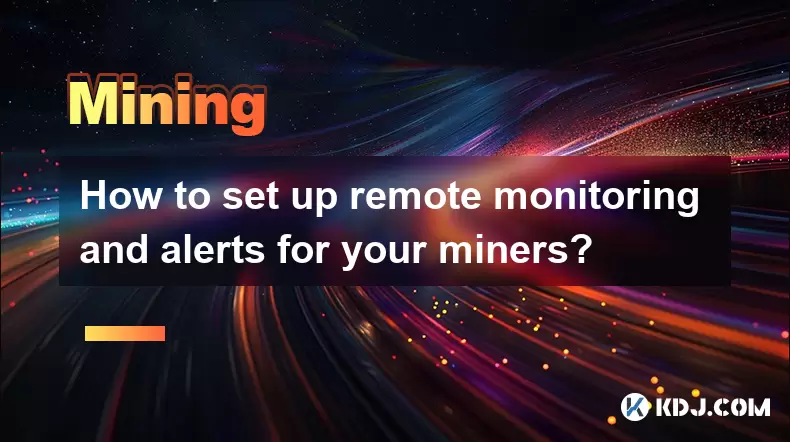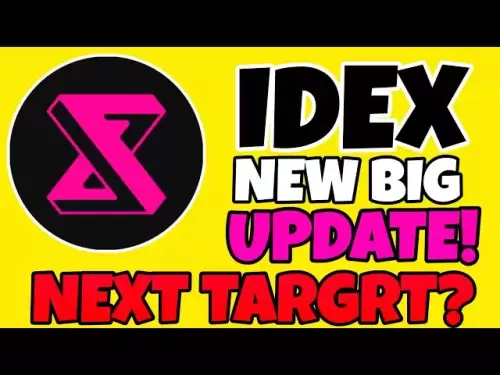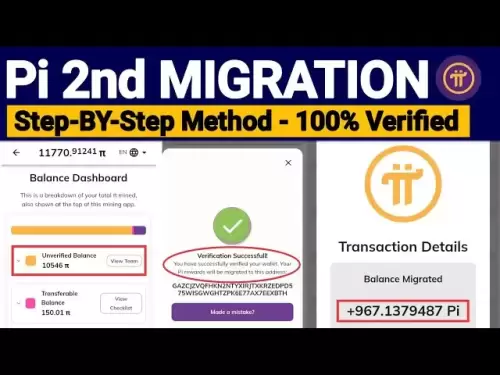-
 Bitcoin
Bitcoin $117,991.5647
-0.03% -
 Ethereum
Ethereum $2,966.4808
0.18% -
 XRP
XRP $2.8076
0.64% -
 Tether USDt
Tether USDt $1.0003
0.00% -
 BNB
BNB $689.9050
-0.63% -
 Solana
Solana $162.0407
-0.80% -
 USDC
USDC $0.9999
0.00% -
 Dogecoin
Dogecoin $0.1995
-1.51% -
 TRON
TRON $0.3001
-1.21% -
 Cardano
Cardano $0.7426
3.25% -
 Hyperliquid
Hyperliquid $47.7978
2.84% -
 Stellar
Stellar $0.4411
16.52% -
 Sui
Sui $3.4267
0.15% -
 Chainlink
Chainlink $15.3148
0.07% -
 Bitcoin Cash
Bitcoin Cash $506.5880
-1.91% -
 Hedera
Hedera $0.2222
12.41% -
 Avalanche
Avalanche $21.2049
1.67% -
 UNUS SED LEO
UNUS SED LEO $9.0606
-0.19% -
 Shiba Inu
Shiba Inu $0.0...01325
-0.86% -
 Toncoin
Toncoin $2.9979
0.32% -
 Litecoin
Litecoin $94.3717
1.13% -
 Polkadot
Polkadot $3.9873
-0.29% -
 Monero
Monero $336.1497
0.92% -
 Dai
Dai $0.9999
-0.01% -
 Uniswap
Uniswap $8.5189
-0.60% -
 Ethena USDe
Ethena USDe $1.0005
-0.04% -
 Pepe
Pepe $0.0...01236
-0.92% -
 Bitget Token
Bitget Token $4.4002
-0.23% -
 Aave
Aave $303.5433
1.05% -
 Bittensor
Bittensor $391.1314
-0.35%
How to set up remote monitoring and alerts for your miners?
Remote monitoring tools like Minerstat and Awesome Miner help track cryptocurrency miner performance, set alerts for issues like low hashrate or high temperatures, and improve operational efficiency.
Jul 13, 2025 at 08:50 am

Understanding Remote Monitoring for Miners
Remote monitoring of cryptocurrency miners allows users to track performance, manage hardware, and receive alerts without being physically present at the mining location. This is especially useful for large-scale mining operations or for individuals managing miners in distant locations. Remote monitoring tools enable real-time tracking of metrics such as hashrate, temperature, power consumption, and uptime. Alerts can be configured to notify users of anomalies like hardware failures, internet outages, or performance drops. This setup not only improves operational efficiency but also helps in maintaining profitability by ensuring miners are always functioning optimally.
Choosing the Right Monitoring Software
Several software solutions are available for remote monitoring of mining rigs. Popular options include Awesome Miner, Minerstat, 2Miners Dashboard, and NiceHash Stats. Each platform offers unique features tailored for different mining needs. For instance, Awesome Miner supports multiple mining software and hardware types, while Minerstat provides detailed analytics and alert systems. When selecting a monitoring tool, consider the following:
- Compatibility with your mining software and hardware
- User interface and ease of use
- Alert mechanisms (email, SMS, Telegram, etc.)
- Data retention and historical performance tracking
It is essential to test different platforms to determine which one aligns best with your mining setup and monitoring goals.
Setting Up Remote Access to Your Miners
Before configuring monitoring and alerts, ensure that your miners are accessible remotely. This typically involves:
- Enabling SSH access on the mining rig or mining OS (e.g., HiveOS, EthOS)
- Configuring port forwarding on your local network router to allow external access
- Setting up a static IP address or using a dynamic DNS service to maintain consistent connectivity
- Using a secure connection (e.g., SSH tunneling or a Virtual Private Network) to protect against unauthorized access
Proper firewall configuration is crucial to prevent unauthorized access while allowing monitoring tools to communicate with the mining devices. Port 443 (HTTPS) or Port 22 (SSH) are commonly used for secure remote access.
Configuring Alerts in Monitoring Platforms
Most mining monitoring platforms allow users to set up custom alerts based on specific conditions. Here’s how to configure alerts in Minerstat as an example:
- Log in to your Minerstat dashboard
- Navigate to the "Alerts" section
- Select the type of alert you want to set (e.g., offline miner, low hashrate, high temperature)
- Choose the notification channel (email, Telegram, Discord, or SMS)
- Set the threshold values for triggering the alert (e.g., if hashrate drops below 90% of expected)
Other platforms like Awesome Miner offer similar functionality, often with integration support for third-party alert services. Custom scripts can also be used to trigger alerts based on log files or system metrics.
Using Third-Party Services for Enhanced Monitoring
For advanced monitoring needs, integrating third-party services can provide additional layers of oversight and automated responses. Tools like Grafana paired with Prometheus can visualize mining performance over time, while IFTTT (If This Then That) can automate alert triggers based on specific conditions. Some benefits of using third-party services include:
- Custom dashboards for real-time monitoring
- Automated actions (e.g., restarting a miner via SSH when it goes offline)
- Integration with cloud storage for long-term data logging
Ensure that API keys and credentials are stored securely and that access is limited to trusted users. Two-factor authentication should be enabled wherever possible to protect sensitive mining data.
Optimizing Alert Sensitivity and Frequency
One of the challenges in setting up alerts is avoiding false positives while ensuring important issues are not missed. To fine-tune your alert system:
- Adjust sensitivity thresholds based on historical performance data
- Avoid overloading with notifications by grouping related alerts
- Test alert triggers by simulating common failure scenarios
- Review and refine alert rules periodically based on actual miner behavior
For example, setting a temperature alert at 85°C may be too aggressive for some GPUs, while setting it at 95°C might be too late to prevent damage. Monitoring logs and performance trends can help in finding the optimal alert thresholds.
Frequently Asked Questions
Q: Can I monitor miners without an internet connection?
A: No, remote monitoring requires a stable internet connection to communicate with the mining hardware and the monitoring platform.
Q: How do I know if my miner is underperforming?
A: Monitoring tools display real-time hashrate data. If the hashrate consistently falls below the expected value for your hardware, it may indicate underperformance.
Q: Can I receive alerts via SMS or mobile app?
A: Yes, platforms like Minerstat and IFTTT allow you to configure SMS notifications or mobile app alerts through services like Telegram or Discord.
Q: Is it safe to expose my miner to the internet for remote access?
A: Remote access should be configured securely using SSH, VPNs, or reverse tunnels to prevent unauthorized access and protect your mining operation.
Disclaimer:info@kdj.com
The information provided is not trading advice. kdj.com does not assume any responsibility for any investments made based on the information provided in this article. Cryptocurrencies are highly volatile and it is highly recommended that you invest with caution after thorough research!
If you believe that the content used on this website infringes your copyright, please contact us immediately (info@kdj.com) and we will delete it promptly.
- Little Pepe, Pepe Coin, and Bonk: Meme Coin Mania Sweeping Crypto in 2025!
- 2025-07-13 22:36:38
- ADA, NEAR, BlockDAG: Crypto Trends and Insights You Can't Miss (NYC Style)
- 2025-07-13 22:36:38
- TRUMP Tokens Unlocked: A Deep Dive into World Liberty Financial and Aqua 1's $100M Investment
- 2025-07-13 22:50:37
- Cryptos Under $0.10: Solana's Successors and the Top 10 Potential
- 2025-07-13 22:50:37
- Crypto, Gold, and Bitcoin: A New York Minute on the Digital Gold Rush
- 2025-07-13 20:30:16
- Crypto iGaming in India: JetTon, LunarBet, and the Evolving Landscape
- 2025-07-13 20:50:16
Related knowledge

How to keep a mining rig cool
Jul 12,2025 at 01:42pm
Understanding the Importance of Cooling in Mining RigsCryptocurrency mining is an intensive process that places heavy demand on hardware components, p...

How much does it cost to start crypto mining?
Jul 13,2025 at 12:22am
Understanding the Basic Costs of Crypto MiningStarting crypto mining involves several upfront and ongoing expenses. The primary costs include hardware...

What is the most profitable crypto to mine?
Jul 13,2025 at 07:00am
Understanding Mining Profitability in CryptocurrencyWhen evaluating the most profitable crypto to mine, it's essential to consider several factors tha...

What do I need to start mining crypto?
Jul 13,2025 at 12:28am
Understanding the Basics of Crypto MiningCrypto mining is the process by which transactions are verified and added to a blockchain, and new coins are ...

How does crypto mining work?
Jul 13,2025 at 11:01am
Understanding the Basics of Crypto MiningCrypto mining is the process through which new cryptocurrency coins are introduced into circulation and trans...

How to find the best Dogecoin mining pool for me
Jul 12,2025 at 04:14pm
Understanding the Role of a Mining PoolWhen mining Dogecoin, joining a mining pool can significantly increase your chances of earning consistent rewar...

How to keep a mining rig cool
Jul 12,2025 at 01:42pm
Understanding the Importance of Cooling in Mining RigsCryptocurrency mining is an intensive process that places heavy demand on hardware components, p...

How much does it cost to start crypto mining?
Jul 13,2025 at 12:22am
Understanding the Basic Costs of Crypto MiningStarting crypto mining involves several upfront and ongoing expenses. The primary costs include hardware...

What is the most profitable crypto to mine?
Jul 13,2025 at 07:00am
Understanding Mining Profitability in CryptocurrencyWhen evaluating the most profitable crypto to mine, it's essential to consider several factors tha...

What do I need to start mining crypto?
Jul 13,2025 at 12:28am
Understanding the Basics of Crypto MiningCrypto mining is the process by which transactions are verified and added to a blockchain, and new coins are ...

How does crypto mining work?
Jul 13,2025 at 11:01am
Understanding the Basics of Crypto MiningCrypto mining is the process through which new cryptocurrency coins are introduced into circulation and trans...

How to find the best Dogecoin mining pool for me
Jul 12,2025 at 04:14pm
Understanding the Role of a Mining PoolWhen mining Dogecoin, joining a mining pool can significantly increase your chances of earning consistent rewar...
See all articles

























































































